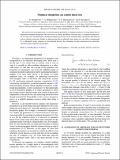Nonlinear dissipation can combat linear loss
Date
28/06/2013Metadata
Show full item recordAbstract
For nonclassical state generation, we demonstrate the possibility to compensate effects of strong linear loss by engineered nonlinear dissipation. We show that it is always possible to construct such a dissipative gadget that, for a certain class of initial states, the desired nonclassical state can be attained within a particular time interval with an arbitrary precision. Further we demonstrate that an arbitrarily large linear loss can still be compensated by a sufficiently strong coherent or even thermal driving, thus obtaining strongly nonclassical (in particular, sub-Poissonian) stationary mixed states.
Citation
Mogilevtsev , D , Mikhalychev , A , Shchesnovich , V S & Korolkova , N 2013 , ' Nonlinear dissipation can combat linear loss ' , Physical Review. A, Atomic, molecular, and optical physics , vol. 87 , no. 6 , 063847 . https://doi.org/10.1103/PhysRevA.87.063847
Publication
Physical Review. A, Atomic, molecular, and optical physics
Status
Peer reviewed
ISSN
1050-2947Type
Journal article
Description
This work was supported by Belarusian Republican Foundation for Fundamental Research (BRFFI) of Belarus, by National Academy of Science of Belarus through the Program “Convergence”, by the External Fellowship Program of the Russian Quantum Center at Skolkovo, by the BrazilianAgency FAPESP (Project No. 2011/19696-0) (D.M.) and has received funding from the European Community’s Seventh Framework Programme (FP7/2007-2013) under Grant Agreement No. 270843 (iQIT).Collections
Items in the St Andrews Research Repository are protected by copyright, with all rights reserved, unless otherwise indicated.

